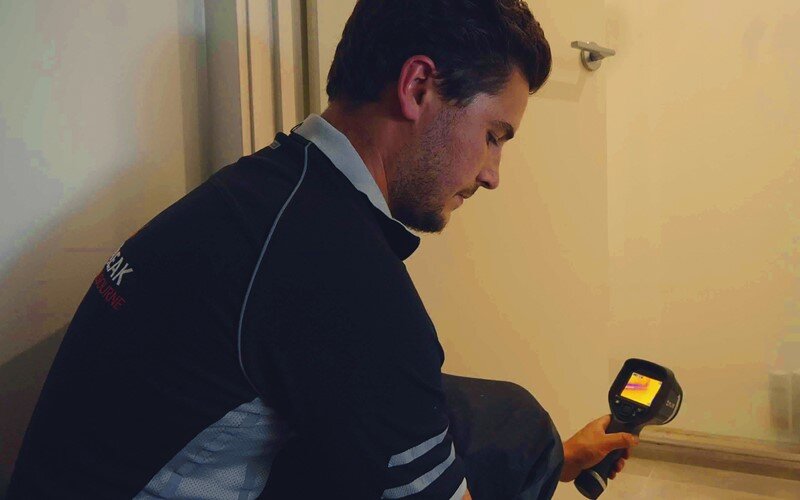Detecting Secret Water Line Leaks: 6 Useful Detection Tricks
Detecting Secret Water Line Leaks: 6 Useful Detection Tricks
Blog Article
We have discovered the article about Leaking water lines below on the net and think it made perfect sense to talk about it with you on my blog.

Early discovery of dripping water lines can mitigate a prospective catastrophe. Some little water leakages might not be visible.
1. Analyze the Water Meter
Every home has a water meter. Inspecting it is a guaranteed manner in which aids you uncover leakages. For beginners, switch off all the water resources. Make sure nobody will flush, use the faucet, shower, run the cleaning equipment or dish washer. From there, most likely to the meter as well as watch if it will alter. Considering that nobody is using it, there need to be no activities. That indicates a fast-moving leak if it moves. If you discover no changes, wait a hr or two as well as check back once again. This means you may have a slow-moving leak that can also be underground.
2. Check Water Usage
Examine your water costs and track your water consumption. As the one paying it, you should discover if there are any inconsistencies. If you identify sudden changes, in spite of your usage being the same, it implies that you have leaks in your plumbing system. Remember, your water costs need to drop under the same array on a monthly basis. An abrupt spike in your expense indicates a fast-moving leakage.
At the same time, a consistent increase on a monthly basis, despite the very same practices, reveals you have a slow-moving leak that's likewise gradually escalating. Call a plumber to extensively examine your building, especially if you really feel a cozy location on your flooring with piping below.
3. Do a Food Coloring Examination
When it comes to water intake, 30% comes from commodes. If the shade in some way infiltrates your dish throughout that time without flushing, there's a leakage between the tank and dish.
4. Asses Outside Lines
Don't forget to check your outside water lines as well. Ought to water seep out of the connection, you have a loose rubber gasket. One small leakage can squander heaps of water and also spike your water bill.
5. Examine and Analyze the Scenario
Property owners need to make it a practice to inspect under the sink counters and also even inside cupboards for any kind of bad odor or mold growth. These two red flags suggest a leakage so punctual attention is required. Doing routine examinations, also bi-annually, can conserve you from a major issue.
Extra notably, if you recognize your residence is currently old, maintain a watchful eye on your heating systems, tubes, pipelines and so on. Look for stainings and compromising as many pipelines as well as home appliances have a life span. They will additionally naturally deteriorate due to wear and tear. If you think leaking water lines in your plumbing system, don't wait for it to escalate. Call an expert plumber right now so you do not end up with a horrible mess in your house.
Early detection of dripping water lines can minimize a possible calamity. Some little water leakages might not be visible. Checking it is a surefire means that aids you find leaks. One tiny leakage can lose heaps of water and increase your water bill.
If you think leaking water lines in your plumbing system, do not wait for it to rise.
How to Know If Your Home Has a Hidden Leak
Water Meter Reveals Inexplicable Water Usage
If you’d like to test whether or not there’s a leak somewhere in your home, you can do this using your water meter. Here is how to conduct the test:
Don’t use any water in your home for at least 30 minutes; this also means not turning on faucets or water-using appliances.
Go outside, and check your water meter for activity.
If your water meter shows that there was activity, even though no one was using any water, this proves that there is a leak in your home.Visible Mold or Mildew Growth
Leaks behind walls create moist, dark environments that allow mold and mildew to grow and thrive. Eventually, you might see mold growth forming on the wall closest to a hidden leak.
If mold is growing in an area that receives a high amount of moisture, such as a bathroom, it may simply be an indication that better ventilation is needed. However, if you see mold growth on a wall or the ceiling in an area where you would not expect, you probably have a hidden leak.
Musty, Mildew Odor
Sometimes you might not be able to see the mold or mildew that is growing as a result of a leak. However, the smell can give the problem away just as easily. If you catch a whiff of something musty, there’s a good chance that old water is collecting somewhere in your home that you can’t see.
Stained/Warped Walls, Ceilings, or Floors
When your home soaks up water, a variety of red flags can become visible, including ceiling stains, bubbling drywall, warped walls, and sagging floors. While these issues can be caused by excess humidity, they can also be signs that a pipe or plumbing connection has started leaking behind your walls.
Inexplicably High Water Bill
After a while, you get a general sense for what your water bill should be. If you own a pool or sprinkler system, your bill will tend to be higher during summer. However, if you receive a water bill that seems especially high, and you can’t figure out what caused it, then you may have a hidden leak somewhere that’s increasing your bill.
https://www.plumbingjoint.com/blog/2019/july/how-to-know-if-your-home-has-a-hidden-leak/

Do you enjoy reading about Top leak detection hacks? Try leaving feedback further down. We would be delighted to listen to your opinion about this page. In hopes to see you back again in the future. For those who liked our blog entry if you please don't forget to share it. Thanks for taking the time to read it.
Get the best, ring us! Report this page